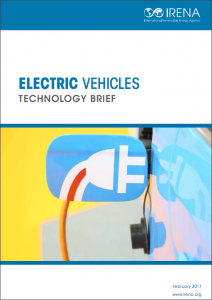Full Title: Electric vehicles: Technology brief
Author(s): International Renewable Energy Agency
Publisher(s): IRENA
Publication Date: February 1, 2017
Full Text: Download Resource
Description (excerpt):
The global stock of electric vehicles (EVs) reached 1 million in 2015 and exceeded 2 million by the end of 2016. Yet faster growth is needed for EVs to fulfil their role in the global energy transition, both through lowering vehicle emissions and boosting renewable energy use.
This brief outlines the technological and policy advances still needed for EVs to help drive the transition to a sustainable global energy future.
Increasing reliance on EV batteries and charging stations would support higher shares of solar and wind power, the key variable renewable energy (VRE) sources expected to be prominent in future power grids.
Transport accounts for about 30% of global energy use. EVs, therefore, form a crucial part of REmap – the global roadmap from the International Renewable Energy Agency (IRENA) to double renewables in the energy mix by 2030. Global growth to 160 million EVs could support VRE-based power generation on a large scale, the analysis finds.
EV deployment depends on four concurrent strategies to ensure maximum benefits:
- electrification of vehicles;
- provision of sufficient charging equipment;
- decarbonisation of power generation; and
- EV integration with the grid.
Early success with EV adoption in key countries and cities offers valuable lessons. For example, policy packages can incentivise electric driving, not just electric buying. A mix of pricing measures and regulations can work well, particularly in combination with direct government support for infrastructure development. While public charging facilities are important, most charging needs can be met without fast charging facilities.
Two main types of EV have achieved substantial sales to date: battery electric vehicles (BEVs), which need to be plugged in to recharge; and plug-in hybrid electric vehicles (PHEVs), which use a combination of battery power and liquid fuel. Smart charging and demand-side management can improve the cost-effectiveness of charging infrastructure.
